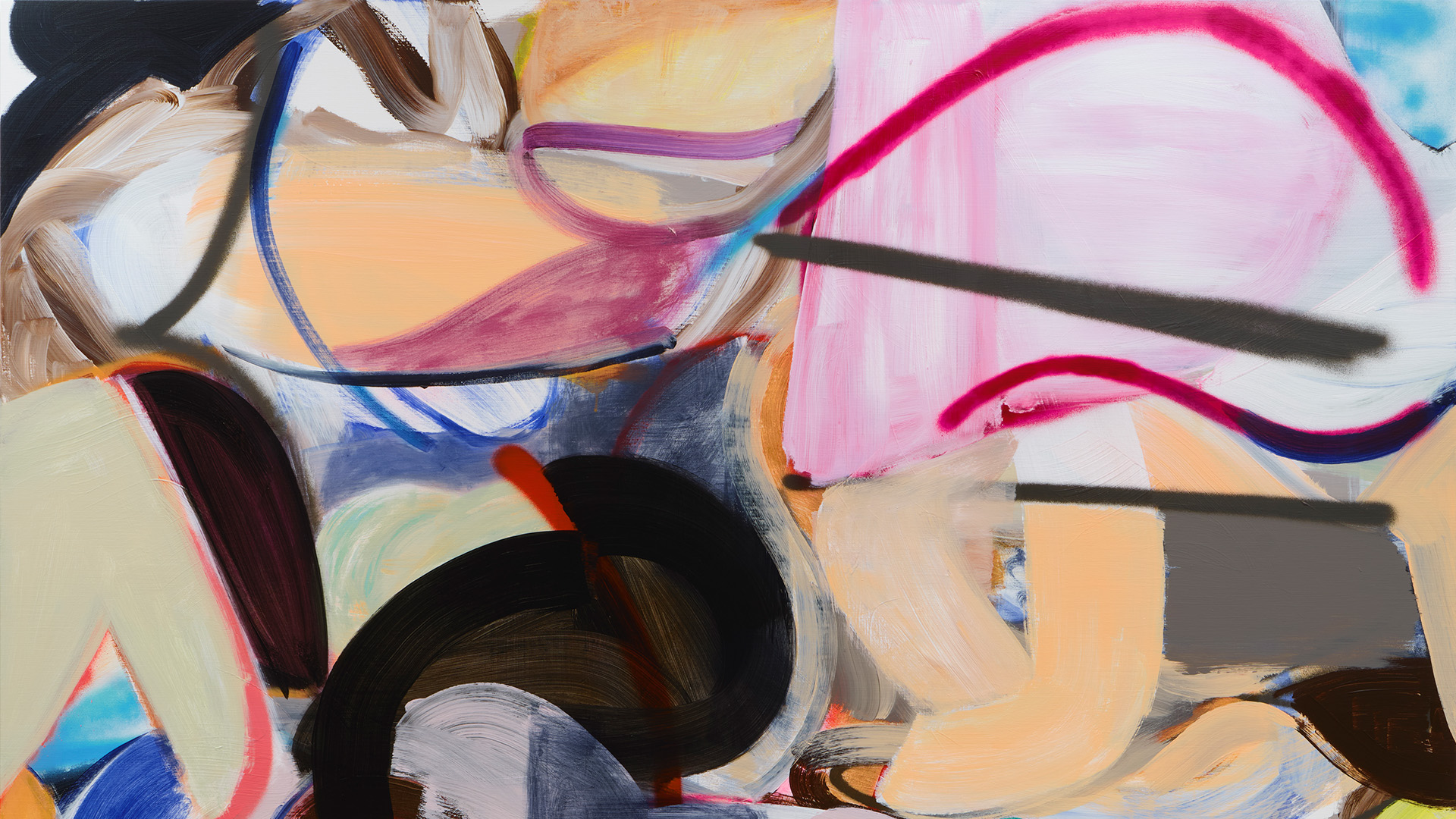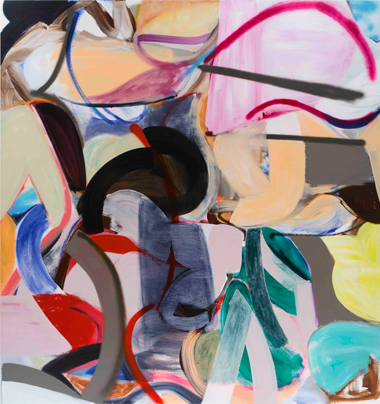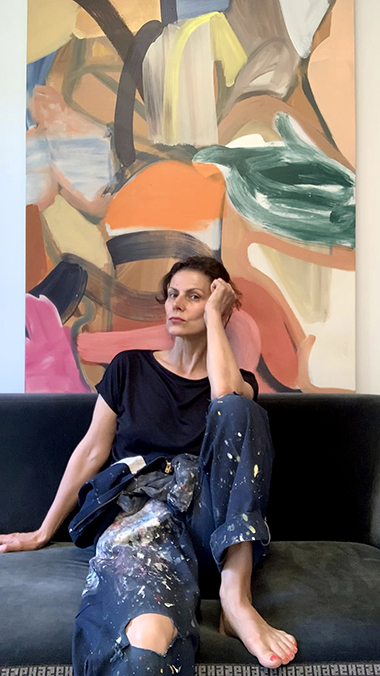

The Conundrum of the Organically Angular
Liliane Tomasko at Maison La Roche
2 September — 4 October
The Fondation Le Corbusier is presenting Liliane Tomasko’s first solo exhibition in Paris at Maison La Roche. In The Conundrum of the Organically Angular, the artist unveils a new series of abstract, gestural paintings that resonate with the modernist architecture of Maison La Roche, designed and built between 1923 and 1925. Tomasko’s vital, gesturally abstract works unfold as painterly cartographies of the unconscious, reflecting on inner states and spatial experience.
„Where would the subconsciousness be located? And how does such an intensely interior organism relate to the outside world? As a bridge between the two locations; between the inner and outer? All of my work is a mediation of this very subject and the big question in a sense is not who or what we are, but where do we reside, where is our locus?“
“Le Corbusier’s Maison La Roche, designed and built between 1923 and 1925 as both a residence and private gallery for the banker and collector Raoul La Roche, forms a richly resonant setting for the latest paintings by Liliane Tomasko. Le Corbusier understood the house not as a mere shell, but as an integrated and functional system. The visitor who walks through it, discovers and experiences it in a sensual way and in movement, perceives it from ever new viewpoints, from new perspectives and vistas, in its interplay of colored walls, and ever-changing light conditions. The surrounding nature and urban landscape are always part of this experience: one looks out through one window and back inside through another, and always understands the external environment as part of the house: “L’intérieur et l’extérieur sont un tout” (“The inside and the outside form a whole”). For Tomasko, too, this permeability is essential: her work has long navigated the threshold between inner life and the visible world, exploring the textures of our inner condition and how we inhabit space and self.
In recent years, Liliane Tomasko has developed a dense visual vocabulary grounded in abstraction, gesture, and emotional immediacy. The paintings exhibited at Maison La Roche – some conceived in direct dialogue with the building, others independent of it – resemble shifting topographies of the unconscious. Broad swaths of luminous color are traversed by bands, arcs, and looping lines that emerge, pulse, or dissolve into their grounds. Tomasko’s formal language has grown increasingly voluminous and spatial, at times even sumptuous. Her paintings evoke natural cycles of growth and unfolding: the coiling of plant forms, the swelling of clouds, the interweaving of branches or mangrove-like plants. Their elastic rhythms echo an early modernist vocabulary – from Cubism and biomorphic forms to Abstract Expressionism, and even the bouncing iconography of comic books or the tags of graffiti. Tomasko’s lines resemble marks, sometimes almost signs of thought or impulse. At times they suggest a moment of sudden clarity, elsewhere a reverberation, a trace. They recall de Kooning’s gestural lines; yet equally present is the resonance of calligraphy. They are gesture and trace, inscription and expression of an inner fabric – the “inner jungle” Tomasko herself speaks of – and they possess an expressive autonomy that borders on the archaic: portraits of the self in flux, states of becoming. Tomasko refers to some of the works shown at Maison la Roche as „Shapeshifters“ – a term that speaks to both their creation process and their mutability, but also to the deep-rooted mythological and psychological currents that shape her practice.
This idea of transformation finds a natural counterpart in Maison La Roche. Le Corbusier’s “promenade architecturale”, which he first experienced in relation to this very house, offers a continuously unfolding sequence of experiences, a choreography of form, color, light, and motion. In Tomasko’s paintings, the viewer, too, is invited to move: not simply across the picture plane, but through states of sensation. Her works created specifically for the Maison reflect this mutual responsiveness – angular forms meeting rounded gestures; moving curtains subtly recalling her earlier, more figurative work. Other works, although not specifically created for the site, echo the organic forms and freer pictorial language that Le Corbusier explored in his painting. In this sense, Maison La Roche does more than provide a setting for the works: it acts as a living counterpoint, a true “shapeshifter”, masterfully balanced between curves and lines, movement, restraint, and volume.”
Barbara Huttrop
The exhibition is presented by Fondation Le Corbusier in collaboration with Kerlin Gallery and Barbara Huttrop | Art Projects. A catalogue, published in collaboration with Kerlin Gallery, Dublin, will feature texts by Tanja Pirsig-Marshall and Loïc Le Gall, as well as a conversation between Liliane Tomasko and Barbara Huttrop. It is scheduled for release at the end of September.


About the artist
Liliane Tomasko lives and works in Nyack, New York, and Aix-en-Provence.
Born in Zurich in 1967, she studied at Chelsea College of Art and Design (BA, 1995) and at the Royal Academy of Arts in London (MA, 1998)
Following an initial focus on sculpture and photography, Tomasko turned to painting within a figurative idiom, exploring interiors of the inner world: often overlooked, dimly lit corners of rooms, the shadowed folds of a curtain, or the blurred edge of a staircase – spaces imbued with quiet mystery and an animate presence. Folds of fabric or clothing, frequently rendered so softly that they seemed on the verge of dissolving, as well as the recurring motif of the unmade bed, played a central role in her work over many years, carrying through even into her later abstraction. These early paintings were not only portraits of domestic interiors and emotionally charged places, but also evocations of an inner state—situated between the rational clarity of waking life and the depth of the unconscious.
It was the creases in bedsheets and the impressions left by bodies upon them that, around 2014, became the bridge to abstraction, providing the structural underpinning of a new painterly language. Yet the emotional urgency of the earlier works remained present. Tomasko’s abstractions continued to process emotion, thought, dream, and the unconscious – gradually extending into a sustained inquiry into the nature of the self, the principle of its seemingly infinite generation of imagery, emotion, and creative force.
What was once marked by a productive melancholy (Kirsten Voigt) – palpable both in her figurative work and early abstractions – has, in more recent years, opened into a visual language shaped by rhythmic fluidity, playfulness, and an organic ease of form. Where earlier paintings held a deliberate sense of unresolved tension, her recent works seem to have entered a dynamic state of flow. Increasingly, figurative elements have begun to surface once more within Tomasko’s abstract compositions. As in her earlier work, such moments often trace the memory of a place – be it a neglected storage room filled with materials at Dublin’s Douglas Hyde Gallery, where she exhibited, or, now, Le Corbusier’s Maison La Roche in Paris.
Following exhibitions at the Hôtel des Arts, Centre Méditerranéen d’Art, Toulon (2008), and Château La Coste in southern France (2019), her exhibition at Maison La Roche marks her first solo exhibition in Paris.